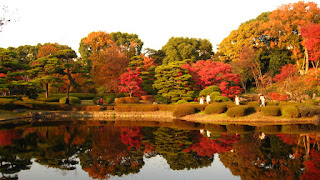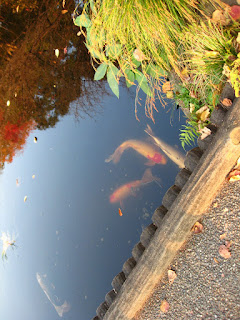 I was lucky enough to be in Tokyo for the January Sumo Tournament- one of the three Sumo tournaments that visit Tokyo annually. It was day 7 of a 15 day event and a Friday so the crowds were pretty impressive for an event only halfway through its course. The sport of sumo is deeply steeped in history and tradition. It was a learning event as much as a sporting event and it kept me enthralled since the moment I walked into the arena.
I was lucky enough to be in Tokyo for the January Sumo Tournament- one of the three Sumo tournaments that visit Tokyo annually. It was day 7 of a 15 day event and a Friday so the crowds were pretty impressive for an event only halfway through its course. The sport of sumo is deeply steeped in history and tradition. It was a learning event as much as a sporting event and it kept me enthralled since the moment I walked into the arena.Ah, where to begin! We have so much to cover, ladies and gentlemen. Sumo's origins date back to prehistory but enters historical writings around the eighth century. Sumo also appears in Japanese mythology and a popular story details that the fate of the Japanese people was won in a Sumo match between two gods. Sumo took the shape that it is presently in the Edo period of Japan. Sumo is closely tied to to both military and religion and has been used as a military training tool and as a way to offer prayer. More on the religious aspects to follow. The sport gradually became more spectator friendly as it moved into the royal courts and as new rules and techniques were applied. Approximately 4 centuries ago, the Nihon Sumo Kyokai (Japan Grand Sumo Association) was formed. This is the same organization that governs professional Sumo today. Over the course of history, Sumo grew from a no-holds-barred battle to the death of the ancients into the sport that is so much more than a contest of strength.
 The three tournaments that take place in Tokyo (three more are held elsewhere in Japan) are held in the Ryogoku Kokugikan. This building has the capacity for 13000 spectators and is sometimes used for other events such as boxing and concerts. As we approached the Kokugikan, banners which bore the names of the wrestlers marked the road. Large murals which depicted wrestlers and previous Sumo matches were displayed on the outer walls. We entered and set to finding our seats. My Aunt, Uncle and I somehow managed to ask for directions, understood them and then amazingly enough, found them. Before we sat down, we payed a visit to the concession stand where we picked up some nuts, beverage and dried squid. Unfortunately, the bento boxes where sold out. A bento is a typical inexpensive lunch tray that houses all sorts of goodies and is popular with students and businessmen. During tournament time, the concession stand sells each of the top wrestler's favorite bento. Also available at the stand is a dish called chanko-nabe. Chanko is what the wrestlers eat to bulk up. The wrestlers eat this stew twice a day and is full of all sorts of things. Basically whatever is available goes into the chanko. Popular ingredients include vegetables: bok choy, daikon, meat products: chicken, fish, beef. Also, no Japanese dish would be complete without a little bit of rice and beer to up the caloric intake. Another little tasty nugget of trivia- during tournament time, the only meat that is put in the chanko is chicken because the hope is that the wrestler will stay on two feet during his match.
The three tournaments that take place in Tokyo (three more are held elsewhere in Japan) are held in the Ryogoku Kokugikan. This building has the capacity for 13000 spectators and is sometimes used for other events such as boxing and concerts. As we approached the Kokugikan, banners which bore the names of the wrestlers marked the road. Large murals which depicted wrestlers and previous Sumo matches were displayed on the outer walls. We entered and set to finding our seats. My Aunt, Uncle and I somehow managed to ask for directions, understood them and then amazingly enough, found them. Before we sat down, we payed a visit to the concession stand where we picked up some nuts, beverage and dried squid. Unfortunately, the bento boxes where sold out. A bento is a typical inexpensive lunch tray that houses all sorts of goodies and is popular with students and businessmen. During tournament time, the concession stand sells each of the top wrestler's favorite bento. Also available at the stand is a dish called chanko-nabe. Chanko is what the wrestlers eat to bulk up. The wrestlers eat this stew twice a day and is full of all sorts of things. Basically whatever is available goes into the chanko. Popular ingredients include vegetables: bok choy, daikon, meat products: chicken, fish, beef. Also, no Japanese dish would be complete without a little bit of rice and beer to up the caloric intake. Another little tasty nugget of trivia- during tournament time, the only meat that is put in the chanko is chicken because the hope is that the wrestler will stay on two feet during his match. In the middle of the arena stands the dohyo- the platform on which all of the wrestling takes place. The Dohyo is a square platform of clay and is covered witha very fine sand. The ring is formed by rice bales buried in the clay. Suspended above is a roof which resembles that of a Shinto shrine with four tassels hanging from the corners which represent the four seasons and four cardinal directions. In between the matches, the sand on the Dohyo is brushed to make sure the wrestlers have an even footing. The sand is also used to determine if a wrestler has touched the ground with a part of his body besides the feet.
In the middle of the arena stands the dohyo- the platform on which all of the wrestling takes place. The Dohyo is a square platform of clay and is covered witha very fine sand. The ring is formed by rice bales buried in the clay. Suspended above is a roof which resembles that of a Shinto shrine with four tassels hanging from the corners which represent the four seasons and four cardinal directions. In between the matches, the sand on the Dohyo is brushed to make sure the wrestlers have an even footing. The sand is also used to determine if a wrestler has touched the ground with a part of his body besides the feet.There are many people involved in the matches to make sure it all runs according to plan.
Yobidashi- The Yobidashi is the go-to guy for the Sumo foundation for all of the odd jobs. The Yobidashi calls the wrestlers to the ring before each match using a traditional song. Other duties of the Yobidashi include building the Dohyo, beating the drums which signal the start and end of a day's tournament, sweep the Dohyo, and traditionally writing songs about Sumo life.
Gyoji- The Giyoji is the referee of the Sumo match. During the match, the Gyoji stands on the Dohyo. The Gyoji starts the match, and the match is only ended when the Gyoji says it is. According to Sumo rules, the match is over when a wrestler is thrown out of the ring or when any part of the wrestler besides the feet touch the ground.
Shimpan- When the Gyoji decides the winner of a tournament, the five Shimpan who sit around the Dohyo can call the decision into consideration. The Shimpan act as the judges of the Sumo tournament.
Rikishi- The Rikishi are the actual wrestlers. Rikishi live and train together in a communal setting where the lower ranked wrestlers serve the higher ranked wrestlers. The tradition of Behya (Sumo stables) is steeped in tradition (what isn't around here?) and rankings play an integral part in the Sumo life.

 Alright, now for the partay.
Alright, now for the partay.Before the Rikishi enter the ring, they wash their mouths with purified water. This tradition is also found in Shinto temples before worship. Every time the Rikishi enter the Dohyo, they throw salt into the ring to mark the ring as a sacred place and to cast out demons. When they enter the ring, they squat down and show their palms to the Gods to demonstrate they are unarmed. The wrestlers stomp to drive out demons and a face-melting stare-off ensues. The goal of the stare-off is to break the opposing Rikishi's focus and to intimidate them. When the tension finally explodes, the wrestlers lunge at each other with full force. The belt the rikishi wear, the mawashi, is used in the technique of the fighters. The bouts usually last only a few seconds but they are some of the most exciting moments in the sporting world.
 The bouts are fought in order of rank. Earlier in the day, the juryo division wrestles. This division is kind of the "minor league" of Sumo. When the juryo division is finished, the maku-uchi take the ring. In the maku-uchi there are more divisions of rank. There are around 15 maegashira, the lowest tier of the maku-uchi division. Above that is the Komusubi. Ahead of the Komusubi is the Sekiwake. The second highest rank a wrestler can attain is the rank of Ozeki which is topped by the highest rank in Sumo, the Grand Yokozuna.
The bouts are fought in order of rank. Earlier in the day, the juryo division wrestles. This division is kind of the "minor league" of Sumo. When the juryo division is finished, the maku-uchi take the ring. In the maku-uchi there are more divisions of rank. There are around 15 maegashira, the lowest tier of the maku-uchi division. Above that is the Komusubi. Ahead of the Komusubi is the Sekiwake. The second highest rank a wrestler can attain is the rank of Ozeki which is topped by the highest rank in Sumo, the Grand Yokozuna.  The excitement of a sumo match is hard to beat. We have hundreds of pound of muscle and tactis hurling through space which is only met with resistance by another solid mass of power. Anyone with common sense knows that this collision will prove for an interesting day of entertainment in the ancient and honorable sport of sumo.
The excitement of a sumo match is hard to beat. We have hundreds of pound of muscle and tactis hurling through space which is only met with resistance by another solid mass of power. Anyone with common sense knows that this collision will prove for an interesting day of entertainment in the ancient and honorable sport of sumo. If anyone is interested, I have more pics and some video of a few of the matches. I couldn't put them up here due to size limitations but if you are interested feel free to shoot me an email.
If anyone is interested, I have more pics and some video of a few of the matches. I couldn't put them up here due to size limitations but if you are interested feel free to shoot me an email.



























